An expert system for acoustic diagnosis of power circuit breakers and on-load
Akhtar Hussain a, Seung-Jae Lee a, Myeon-Song Choi a,∗, Fouad Brikcib
a Department of Electrical Engineering, Myongji University, Yongin, South Korea
b Zensol Automation Inc, Quebec, Canada
Most of the faults on power Circuit Breakers (CBs) and On-Load Tap Changers (OLTCs) on high voltage trans- formers are of mechanical origin. Mechanical malfunction, mechanical wear and other types of abnormal behaviors can be detected as changes in the acoustic signatures. In this paper, an Expert System (ES) with the addition of a signal processor module and factual database module to the conventional ES has been pro- posed for the diagnosis of CBs and OLTCs. The feature extraction of the acoustic signatures has been done by decomposing them into voiced and silent portions in time domain and through FFT spectrum analysis in frequency domain. The OLTC’s motor current has been decomposed into inrush, steady-state and extended currents to locate the cause of different anomalies in the OLTCs and acoustic-current pair has been used for the synchronization testing. Each extracted feature of the testing signal has been compared to the similar feature of a reference signal to not only identify the health of the testing device but also to locate the cause of each anomaly. Several test signals have been compared against the reference signature and the proposed expert system has proved to be a suitable, effective and reliable system for the acoustic diagnosis of OLTCs and CBs.
© 2015 Elsevier Ltd. All rights reserved.
1. Introduction
Circuit Breakers (CBs) are very important elements in the power system. Circuit breakers need to be reliable since their mal-operation can cause major issues with power system protection and control (Runde, Aurud, Lundgaard, Ottesen, & Faugstad, 1992). Since CBs are active links in the fault-clearance chain, CBs must be tested and maintained to ensure their proper operation at crucial times (Runde, Ottesen, Skyberg, & Ohlen, 1996). The circuit breakers have to operate within extremely tight tolerances when a disturbance is detected in a network to protect sensitive and costly equipment. They have to be able to operate even after months, or in some cases years, of inactiv- ity (Vilaithong, Tenbohlen, & Stirl, 2007). So it is desirable to do some periodic testing to prevent damaging costly equipment or to prevent outages when the operation of a CB is required.
On-Load Tap Changers (OLTCs) are one of the problematic com- ponents of power transformers. Detecting faults in OLTCs is one of the key challenges faced by the power equipment predictive main- tenance community (Vilaithong et al., 2007). OLTCs are used to keep the secondary voltage at an acceptable level when the load changes to adjust the transformer phase shift. Tap changer diagnostics are also
∗ Corresponding author. Tel.: +82 313306367.
E-mail address: mschoi@mju.ac.kr, hussainakhtar44@yahoo.com (M.-S. Choi).
important to determine when tap changer maintenance is necessary, and to identify the problems in tap changers (Kezunovic, Latisko, & Ved, 2005). Similar to CBs, the condition of OLTCs is also strategic to the reliability of power transformers. OLTC is the only movable part of a transformer and therefore suffers from various aging problems. Over time, the insulation oil inside the tap changer compartment be- comes dirty due to switching arcs, thereby weakening its insulation properties. Faults associated with tap changers form up to 40% of catastrophic failures in transformers (Landry & Léonard, 2008).
Between 40% and 50% of failures on high voltage CBs and OLTCs on high voltage transformers are of mechanical origins (CIGRE re- port) (Landry & Léonard, 2008). Different methods are used to iden- tify the anomalies that occur in CBs and OLTCs. Of these methods, the most common technique is acoustic diagnostics (Fazio & Muzi, 2003; Leung, 2007; Nagata et al., 2009; Paul & Davis, 1985).
By using the acoustic diagnostics technique, contact-wear, arch- ing in diverter and selector, synchronism problems, drive-mechanism problems and brake failures in OLTCs and incipient rupture of the contact plug shaft, incorrectly assembled crank and major lubrication problems all can be detected in CBs. Existing mature techniques used in speech processing can be utilized for the acoustic diagnosis of CBs and OLTCs.
During the operation of a CB and an OLTC, a series of mechan- ical and electrical events produce distinctive vibration and noise patterns. Acoustic monitoring consists of listening to these vibra- tion patterns and detecting any changes in them. These changes can then be compared with the appropriate reference signatures to de- tect any developing malfunction or possible wear. Acoustic signatures can be recorded by mounting accelerometers onto the mounting base (Landry & Léonard, 2008). The current signal given by the motor driv- ing the OLTC can be captured by an open clamp current sensor. Once the raw data is gathered, it is compared to the reference signature to identify any anomaly in the tested CB or OLTC.
It is necessary to identify the health of CBs and OLTCs for secure and prompt operation (IDA, 2008). There are several causes of abnor- mal behavior and with an increase in experience in dealing with such abnormalities, our knowledge improves. Several analyses have taken place in order to diagnose the health of CBs and OLTCs by using vari- ous methods.
An expert system for acoustic diagnosis of CBs and OLTCs is pro- posed in this paper. The proposed expert system comprises of a knowledge base, factual data base, signal processor, inference engine and a user interface. The knowledge base and factual data base can be updated as, and when, needed. By using the proposed expert system users cannot only identify the health of testing equipment, they can also locate the cause of the particular abnormality in a broader spec- trum. Additionally, a user interface allows the testing crew to simply browse and load the testing and reference signatures.
1. Hussain et al. / Expert Systems With Applications 42 (2015) 9426–9433 9427
2. Literature review and novelty of proposed algorithm
Contact force monitoring based testing methodology for CBs has been proposed by (Tang, Shisong, Xie, & Cheng, 2015), while a ge- netic algorithm with support vector machine based algorithm for identifying mechanical faults in CBs has been presented by (Huang, Hu, & Yang, 2011) and a rough set theory based algorithm was sug- gested by (Yan, Haiguang, & Liang, 2013). Partial discharge detec- tion in CBs, along with diagnostic methods, has been presented by (Nakaoka, Tai, & Kamarol, 2014) and a research for extracting me- chanical state parameters by using travel-time waveform has been carried out by (Tianxu & Xiaoguang, 2013). A unique hybrid method of electrical and chemical techniques for the fault diagnosis of gas- insulated switchgears has been analyzed by (Li, Tang, & Liu, 2015). An acoustic signal processing based on blind-source separation through fast independent component analysis has been discussed in (Zhao & Cheng, 2014) while acoustic signal processing based on wavelet transform has been presented by (Charbkaew, 2012; Mingliang & Keqi, 2014). A comprehensive survey of the testing methodologies used by power engineers for analyzing CBs and disconnectors in the last decade has been reviewed by (Westerlund & Hilber, 2014).
A Ph.D. thesis has been presented in Adelaide University by an-
alyzing the vibro-acoustics of transformers and their application in the condition monitoring of power transformers (Wang, Eng, & Eng, 2015). A study for mathematically modeling the acoustic signal of OLTCs has been presented in Cichon, Borucki, and Wotzka (2014) and methods for extracting characteristics of the acoustic signals gener- ated by OLTCs during operation have been analyzed by Cichon´ and Fra˛ cz (2012). A method for analyzing the arching process in OLTCs based on acoustic signals has been discussed in Bhuyan and Mor (2014). Acoustic Emission Method (AEM) based fault detection in OLTCs has been presented by Cichon´ and Berger (2014). The effect of measuring transducers on the acoustic signatures based on AEM has been analyzed by Faria, Costa, and Olivas (2015) and the possi- bility of using AEM for testing of OLTCs during normal operation has been presented by Cichon´ and Borucki (2012). A review of monitoring methods used in power transformers for predictive maintenance has been presented by Bhattacharya and Dan (2014) and recent trends of condition monitoring for fault diagnosis of equipment has been reviewed by Wang et al. (2015). Fuzzy logic based auto-diagnosis of OLTCs has been suggested by Henriquez and Alonso (2014) and Hu,
Duan, and Yong (2015). An acoustic diagnosis system based on Dy- namic Time Wrapping (DTW) is discussed in the paper presented by Landry and Léonard (2008), where envelopes of testing and reference signals are compared by the testing engineers. The decisions on the health of CBs or OLTCs are made by the testing crew by checking both sets of signatures. This process becomes more difficult if a new case arises.
Firstly, most of the research available in the literature and ref- erenced in this paper focuses on a single problem associated with the CBs or OLTCs. However, the original nature and potential causes of faults in this equipment are enormous. Secondly, all the possible faults in the OLTCs and CBs are not known. Our knowledge about the nature of faults improves with our increasing experience and the oc- currence of non-trivial abnormalities. Thirdly, most of the diagnos- tic techniques available in the literature are based on a ‘YES’ and ‘NO’ approach. The testing equipment is only categorized as normal or abnormal without knowing the possible cause for each particu- lar abnormal behavior. Keeping all this in mind, an expert system is an appropriate solution for this diagnostic problem. Expert systems use human knowledge to solve problems by using rules and data, which can be called upon and updated as and when necessary (Taniar, Gervasi, Murgante, Pardede, & Apduhan, 2010). The proposed artifi- cial intelligence based systems in the literature uses only one domain (time or frequency) analysis, which results in loopholes in the diag- nosis process.
The developed expert system caters for various possible known causes of CBs and OLTCs failures available in the literature, in con- trast to the single problem targeting approaches. It provides a dy- namic testing environment by making use of the knowledge base, which allows the field experts to add new cases as and when re- quired without impacting the rest of the testing system, which is op- posite to the static testing strategies. It provides an interactive en- vironment to the testing crew through the developed user interface and inference engine. In contrast to the conventional procedural code based systems, it provides a rule-based system with a detailed view of the possible causes for each anomaly in testing CB or OLTC. The uniqueness of the proposed expert system in comparison with other artificial intelligence based systems is the use of well-known speech processing techniques and signal analysis in both the time and fre- quency domains. With these major advantages and several other mi- nor benefits (computationally inexpensiveness, analysis of motor cur- rent along with acoustic signature of OLTCs, visualization of testing and reference signatures and easy to change usage), the proposed ex- pert system can be categorized as a novel, reliable, effective and ro- bust method for the testing of OLTCs and CBs.
3. Feature extraction and comparison
The proposed feature extraction and comparison algorithm re- quires only acoustic signals for the diagnosis of CBs, and it requires the acoustic signal as well as the current signal of the motor, which allows the tap-changer to move from one position to another, for complete diagnosis of an OLTC. Acoustic signals can be recorded by using a piezo-electric accelerometer, and the current signals can be measured through an open-clamp current sensor. The sampling fre- quency for both the signals is 100 kHz (Landry & Léonard, 2008). The acoustic signal processing is the same for both OLTCs and CBs. The acoustic signal is processed and analyzed in both the time and fre- quency domains; however, the current signal used for OLTC’s testing is processed only in the time domain. After extracting the features, the corresponding components of the testing signal are compared with those of a reference signal. The testing device is regarded as normal if, and only if, all the differences are within some specified thresholds. This feature extraction and comparison task is achieved through the signal processor module incorporated in the developed expert system. The function of each module will be discussed in detail in the next section.

- Acoustic signal processing
The acoustic signal of CB and OLTC is processed both in a time and frequency domains. In a time domain, the testing signal is decom- posed into the voiced portion and the silence portion as shown in Fig. 1, by using the silence removal technique proposed in the pa- per presented by Saha and Sandipan Chakroborty (2005). After de- composing the acoustic signal, the voice portion of the testing sig- nal is compared with the voiced portion of the reference signal, and the silence portion of the testing signal with the silence por- tion of the reference signal. The reason for decomposing the signal is that the anomaly in the voiced portion is different from that of the silence portion. If the differences are within the specified thresholds, it moves to the next step. Otherwise, it bookmarks the cause of the anomaly (to display at the end of testing) and then moves on to the next step.
After analyzing various signals, a threshold has been defined for each region. If the difference between the testing and the reference signal crosses that threshold value, then the testing CB or OLTC is declared as abnormal. If the voiced portion difference crosses the threshold, the possible causes could be improper installation of braid, bending of the moving arm control, wearing down of the wheel switch, anomaly in the voltage limiter device, or contact wears. If the difference of the silence portion crosses the threshold, then possible causes could be a lack of lubrication in control gear, misalignment of contacts on the selector, breaker failure, or too much carbon in the oil.
Certain types of faults are difficult to visualize in the time domain; so, in addition to time domain analysis, frequency domain analysis has also been performed on the acoustic signals. The block diagram of the frequency domain processing is shown in Fig. 2. After extract- ing the spectrum in the final step, the spectrum of both the reference and testing signal is compared; and if the difference crosses the pre- set threshold, then the OLTC or CB being tested is declared as abnor- mal.
Possible causes for this anomaly could be the wearing down of contacts, noise of mechanism, wearing down of rolls of the main con- tact, weakened springs or lack of lubrication in control gears. Acoustic signal processing alone is enough for CB diagnostics. However, some additional tests are required for OLTCs and have been carried out to cater all the potential failure causes. The two other tests, apart from the acoustic signal testing for OLTC’s diagnostics, are explained in the following sections.
- Current signal processing
For complete diagnosis of OLTCs, current signal processing is also required in addition to the acoustic signal processing as mentioned in the preceding section.
The current signal is decomposed into three portions as shown in Fig. 3 by using the statistical method proposed in the paper presented by Saha and Sandipan Chakroborty (2005). The causes of anomaly in each of the three decomposed portion are different. A threshold is de- fined for each portion: if the difference between the reference current signal and the testing signal crosses the threshold, the testing OLTC is declared as abnormal.
The red portion is the inrush current portion; if the difference of the inrush portion (of reference and testing current signal) crosses the threshold value, then the possible cause could be a slack in the control rod or motor startup contactor. If the difference of the steady state portion (blue) crosses the threshold values, then the possible cause could be faulty control relay or lack of lubrication. If the ex- tended portion (green) difference crosses the threshold value, then the possible cause could be breaker failure. In this way, the anoma- lies associated with the motor current of an OLTC can be categorized into three major types.
- Synchronization testing
In addition to the acoustic and current signal testing, synchro- nization testing is also required for complete diagnosis of an OLTC as shown in Fig. 4.
If a switching operation occurs after the end of the steady state portion of current signal, then the testing OLTC is abnormal and the possible cause is switching synchronization. The proposed algorithm does synchronization testing by comparing the start and end of the voice signal with the end of the steady state current signal. For syn- chronization, testing signals are enough and the reference signal is not required.
For the diagnosis of CBs, only the acoustic processing of signals can deliver desired results, but for OLTCs, apart from acoustic diag- nosis, some further tests are also required. The testing CB will be declared as normal if both the voice portion difference and silence portion difference of the reference and testing signal are within the specified threshold otherwise it will be declared as abnormal. In or- der to declare an OLTC as normal, the result of inrush current differ- ence, steady state current difference and extension current difference should be below the threshold values in addition to positive (normal) acoustic signal tests and synchronization test results.
The flowchart for complete testing of an OLTC is shown in Fig. 5. An OLTC is declared as normal if, and only if, all the tests elaborated in Fig. 5 are fulfilled.

Fig. 3. Decomposition of current signal. (For interpretation of the references to color in this figure, the reader is referred to the web version of this article).
Fig. 4. Synchronization testing of OLTC.
4. Proposed expert system
An Expert System (ES) has the ability to emulate the decision- making ability of experts by making use of computers. The purpose of expert systems is to solve the complex problems through reasoning and they are based on rules in contrast to the conventional procedu- ral code based systems. Conventional Expert Systems only comprise of a Knowledge Base (KB), Inference Engine (IE) and a User Interface (UI) as shown in Fig. 6 (Paul & Davis, 1985).
The KB of an ES is built by using the knowledge of field experts. KB is comprised of some rules and facts which are analyzed by the IE for each case and matched rules are fired by IE. Non-expert users can interact with the system by making use of the UI. The users can inquire the IE about any particular decision made by it.
Fig. 5. Flowchart for diagnosis of an OLTC.
In order to perform the acoustic diagnosis of CBs and OLTCs, an expert system has been proposed in this paper. However, only the conventional structure of ES is not adequate to accomplish this task. Some additional blocks have been added to the conventional systems to make it a more useful tool for the acoustic diagnosis of CBs and OLTCs as shown in Fig. 7.
Two blocks namely Signal Processor (SP) and Factual Data Base (FDB) have been added to the conventional expert systems.
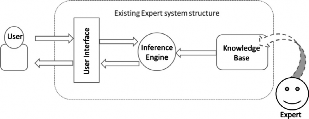
Fig. 6. Conventional expert systems.
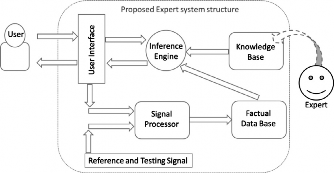
Fig. 7. Proposed expert system.
Both the testing and reference signals will be processed by the signal proces- sor and useful information will be extracted from the signals. Details about the processing and the extraction of useful information from the acoustic signatures and current signals have been discussed in detail in the previous section.
The information extracted by the SP will be stored in the FDB. KB contains the thresholds for each portion of current and acoustic sig- nals and possible causes for each anomaly. IE will check the facts of testing and reference signals against the thresholds in KB; and if any one of the thresholds is being crossed, then the testing OLTC or CB will be declared abnormal and its possible cause/causes will be displayed on the user interface. A simple yet interactive UI has been developed in Matlab; and by using the UI, users can browse and select the test- ing and reference signals from the system and perform diagnostics. Once the diagnosis is finished the UI will display information about the health of the CB or the OLTC that was tested, and provide a brief view of the possible causes for that anomaly. Users can ask for de- tailed information about that particular abnormality by pressing the “Detailed View” tab in the UI as shown in Fig. 8.
Users have been given the liberty to test several testing signatures against a given reference signature. The “RESET” tab inside the Testing Signal Panel (Fig. 8) can be used to select various testing signals. Ei- ther both the signals need to be changed or only the reference signal, then “RESET” tab under Status indication panel can be used.
- Testing procedure
In order to test an acoustic signature of a CB and acoustic-current signal pair of an OLTC by using the proposed algorithm, a series of steps are required. The following steps show the complete procedure from data acquisition to the addition of a fresh case. Chronical order of steps for the testing of a CB or an OLTC is as follows:
- Record the current signal by using an open-clamp current sensor at an adequate sampling
- Record the acoustic signatures by mounting piezo-electric ac- celerometers at different locations (Landry & Léonard, 2008) of a healthy
- Save the recorded data in the form .txt file in a computer and se- lect a single signature as a reference
- Combine the current and acoustic signal into a single .txt file (for OLTC’s )
- Repeat step one to four for recoding and saving the testing signal of an OLTC and step two and three for CB testing
- Upload the reference and a testing signal by browsing the com- puter through “Select REF Signal” and “Select TEST Signal” tab in the developed UI ( 8).
- Click “DIAGNOS” tab below the Testing Signal Panel and wait for complete
- The status of testing CB/OLTC will be shown as Normal or Abnor- mal along with a brief view of possible causes (in abnormal case).
- “Detailed View” tab can be used to analyze the possible cause/causes for that
- Reset tab in the “Testing Signal Panel” can be used to test other testing signals against the same selected reference
- Main reset tab under status indication panel can be used to reset the whole system or to use a new testing pair of reference and testing
- Step from one to nine can be used to store, test and analyze the health of another category/type of an
- Step from two to nine, except step four, can be used for data ac- quisition, testing and diagnosis for a different type of a
The acoustic signature of the OLTCs and CBs can be different based on the manufacturer and type of the selected device. A reference sig- nal for each type of CB/OLTC be selected and used for testing the spe- cific category by using the above mentioned steps. Most of the data acquisition devices for OLTCs testing generate a single text file of the current and acoustic signal; in that case, step three can be omitted. Even if a new case arises, the steps for testing would remain same, however the FDB and IE need to be updated.
5. Test cases
Acoustic data acquisition has been done by planting piezo-electric accelerometers at the mounting base of the tank, and motor current has been recorded by an open-clamp current sensor. The sampling frequency of data acquisition unit has been set to 100 kHz. The raw data has been processed and useful information has been extracted as explained in Section 3 by using Matlab 2013b. The expert system has also been developed in Matlab 2013b, and the user interface has been developed by using Matlab GUI. Some of the test cases, along with their results, are presented in the following sections to show the usability, effectiveness and robustness of the proposed diagnosis method.
- Abnormal OLTC
A reference acoustic-current signature set for an OLTC has been acquired by following the steps mentioned in the previous section. The testing signature set has also been acquired by following the same procedure. The acoustic-current pair of both the testing and reference signals of the testing and reference OLTC is shown in Fig. 8. After analyzing the testing OLTC’s signature set, it has been declared as abnormal by the developed algorithm as depicted in the status tab of the developed GUI in Fig. 8.
The UI has displayed a brief description about the possible causes of the abnormality. Detailed information about the abnormality can be viewed by pressing the detailed view tab in the UI. By analyzing the detailed information and causes of abnormality in each portion, as explained in Section 3, the exact potential cause/causes can be pinpointed.
After analyzing the detailed explanation, it was concluded that there was an abnormality in the voiced portion of the acoustic sig- nal, and inrush portion of the current signal. The abnormality in the voiced portion depicts that the possible causes could be improper in- stallation of braid, bending of the moving arm control, wearing down
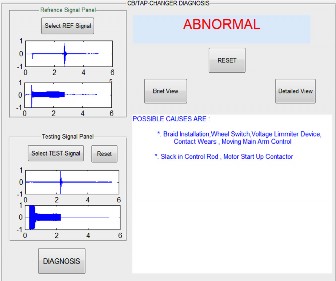
Fig. 8. Testing of an abnormal OLTC.
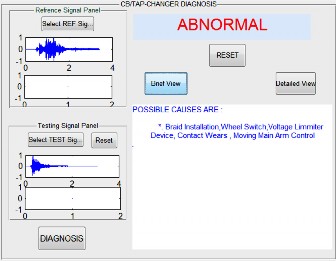
Fig. 9. Testing of a normal OLTC.
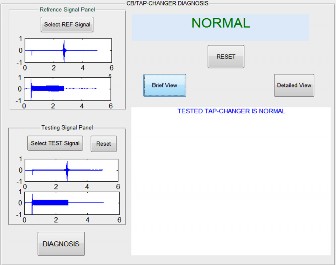
Fig. 10. Testing of an abnormal CB.
of the wheel switch, anomaly in the voltage limiter device, and con- tact wears and anomaly in inrush current means that there is slack in the control rod or motor startup contactor. If multiple testing signa- tures have been recorded in the acquisition step, all of the signals can be tested one-by-one and the final cause of the abnormality can be categorized based on the common results of all the signatures.
- Normal OLTC
A reference acoustic-current signature set and testing acoustic- current set of an OLTC has been acquired in accordance with the steps explained in Section 4. The acquired reference and testing signals have been uploaded and tested by using the developed GUI. Both the reference and testing signals have been acquired from a single OLTC. After analyzing the signals, the testing OLTC has been declared as nor- mal by the developed expert system as shown in the status indication panel of Fig. 9.
An OLTC is declared as normal if, and only if, all the tests which are shown in the flowchart in Fig. 5 are fulfilled. If any one of the tests results is not satisfied, the OLTC being tested is declared as abnormal. Several signatures of the testing OLTC can be stored and tested by making use of the developed algorithm, in order to be sure about the consistency of the decision. In order to declare an OLTC as normal, re- sults of all the signatures acquired from the same OLTC under similar condition should be identical (normal).
- Abnormal CB
The reference signature for a CB has been acquired by following steps two and three mentioned in Section 4. The same process has been used to acquire a testing signature from a different CB. The ref- erence signal is acquired by planting an accelerometer on the CB of phase-C, while the testing acoustic signature is of phase-B’s CB. Both the testing and the reference signatures of the selected CBs are shown in Fig. 10. Fig. 10 only shows the acoustic signatures of the selected CB, since the current signal processing is not required for CB’s testing.
After uploading both signatures, the testing signature has been analyzed against the reference signature, and it has been declared ab- normal by the developed expert system. The abnormal status is de- picted in the status indication panel of Fig. 10 along with the brief overview of possible causes for this abnormality. Detailed informa- tion about this abnormality can be viewed by pressing the detailed view tab in the UI. Multiple acoustic signatures of the testing CB can be tested by using the “Reset” tab in the Testing Signal Panel.
After analyzing the detailed explanation, it was concluded that there was an abnormality in the voiced portion of the acoustic sig- nal. The abnormality in the voiced portion depicts that the possible causes could be improper installation of braid, bending of the mov- ing arm control, wearing down of the wheel switch, anomaly in the voltage limiter device, and contact wears. If multiple testing signa- tures have been recorded in the acquisition step, all of the signals can be tested one-by-one and the final cause of the abnormality can be categorized based on the common results of all the signatures.
- Normal CB
A reference acoustic signature has been acquired by planting an accelerometer on the phase-C CB, in accordance with the steps ex- plained in Section 4. Testing the acoustic signature has been acquired in the same way with an accelerometer on the phase-A’s CB. Both the reference and testing acoustic signature of the selected CBs are shown in Fig. 11. After analyzing the uploaded acoustic signals, the testing CB has been declared normal by the developed diagnosis al- gorithm as shown in the status indication panel of Fig. 11.
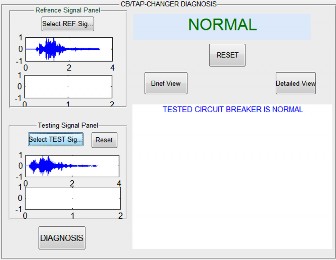
Fig. 11. Testing of a normal CB.
A CB is declared as normal if, and only if, all the tests related to acoustic signal processing as explained in Section 3 are fulfilled. If any one of the tests results in failure, the CB being tested is declared ab- normal. Several signatures of the testing CB can be stored and tested by making use of the developed algorithm, in order to be sure about the consistency of the decision. In order to declare a CB normal, the results of all the signatures acquired from the same CB under similar conditions should be consistent (normal).
A similar type of testing is valid for any type of CB or OLTC un- til, or unless, the reference and testing signals are available. Only an acoustic signal is required to test a CB, while an acoustic and a current signal are both required to test an OLTC. The signature of an OLTC/CB may be manufacturer specific or type specific, therefore a different reference signature should be used if the type is different.
Being an expert system, the proposed diagnostics algorithm in- herits the implications of the expert systems such as lack of routine update of knowledge (as human experts do), lack of common sense, provision of knowledge in a restricted domain and many more. Apart from the inherited limitations, there are some algorithm specific im- plications also. First implication is that, the expert system may not result in unique results even if the testing device and environmental conditions are same. This may be due to the difference in the location and orientation of the accelerometers. However, repeated readings from a unique accelerometer under the same conditions will result in unique outcomes. If the data acquisition system does not generate a single text file for current and acoustic signal of an OLTC, it may re- quire some additional processing to make a single file. However, the data acquisition system used in this study and major portion of the available acquisition systems generate single text files.
6. Conclusions
An expert system has been proposed in this paper for the acoustic diagnosis of OLTCs and CBs. This proposed intelligent system uses the well-developed signal processing techniques utilized for the speech processing for acoustic signature diagnosis. The signal-processing module of the developed expert system analyses the acoustic signa- ture in both the time and frequency domains, which makes it a more reliable, accurate and robust intelligent system. The proposed expert system will not only identify the health of the testing device, but will also locate the possible cause(s) for each anomaly. Newly discov- ered fault cases can be easily added to the knowledge base without affecting the remaining system. A simple yet effective user interface has been developed for non-expert users. Users can interact with the system using the developed UI. Users just need to browse and se- lect the testing and reference signals from the computer. All possi- ble failure causes that have been analyzed and all necessary tests for complete analysis of OLTCs and CBs have been included in the signal processor of the proposed expert system.
Apart from the inherited implications of the expert systems, the proposed intelligent system may result in nonhomogeneous out- comes if the mounting location of accelerometer is different on the same testing device. A single text file containing the acoustic-current data is required for the diagnosis of an OLTC, which may require some additional processing in some cases. In order to make a final decision about the health of the testing device, repeated testing might be re- quired in some cases.
In order to make the proposed intelligent system a flawless test- ing system, apart from the acoustic diagnosis, some other major di- agnostic techniques available in the literature could be added to the knowledge base. The proposed system could be enhanced to take sev- eral acoustic signals as inputs for a given testing device and make a final decision by its own in an intelligent way.
Acknowledgments
This work was supported by the Human Resources Program in Energy Technology of the Korea Institute of Energy Technology Evaluation and Planning (KETEP), granted financial resources from the Ministry of Trade, Industry & Energy, Republic of Korea. (No. 20154030200770).
References
Bhattacharya, A., & Dan, P. (2014). Recent trend in condition monitoring for equipment fault diagnosis. International Journal of System Assurance Engineering and Manage- ment, 5(3), 230–244.
Bhuyan, R., & Mor, A. (2014). Analysis of the arcing process in on-load tap changers by measuring the acoustic signature. In Proceedings of IEEE electrical insulation confer- ence (EIC) (pp. 193–197). Philadelphia, Pennsylvania, USA.
Charbkaew, N. (2012). Vibration signal analysis for condition monitoring of puffer-type high-voltage circuit breakers using wavelet transform. IEEJ Transactions on Electri- cal and Electronic Engineering, 7(1), 13–22.
Cichonn´ , A., & Berger, P. (2014). Possibility of using acoustic emission method for test- ing load tap changers during normal operation of the transformer. In Proceedings of IEEE international conference on high voltage engineering and application (ICHVE) (pp. 1–4). Opole, Poland.
Cichon´ , A., & Borucki, S. (2012). Diagnostics of technical condition on load tap changers by acoustic emission method using different types of measuring transducers. In Proceedings of IEEE international conference on high voltage engineering and applica- tion (ICHVE) (pp. 621–624). Shanghai, China.
Cichon, A., Borucki, S., & Wotzka, D. (2014). Modeling of acoustic emission signals gen- erated in on load tap changer. Acta Physica Polonica A, 125(6), 1396–1399.
Cichon´ , A., & Fra˛ cz, P. (2012). Detection of defects in on-load tap-changers using acous- tic emission method. In Proceedings of IEEE international symposium on electrical insulation (ISEI) (pp. 184–188).
Faria, H. de, Costa, J., & Olivas, J. (2015). A review of monitoring methods for predic- tive maintenance of electric power transformers based on dissolved gas analysis. Renewable and Sustainable Energy Reviews, 46, 201–209.
Fazio, G., & Muzi, F. (2003). Circuit-breaker diagnostics based on continuous wavelet transform. In Proceedings of IEEE conference on power tech (pp. 4–10). Bologna, Italy. Saha, G., & Sandipan Chakroborty, S. S. (2005). A new silence removal and endpoint de- tection algorithm for speech and speaker recognition applications. In Proceedings
of the 11th IEEE national conference on communications (NCC) (pp. 195–291).
Henriquez, P., & Alonso, J. (2014). Review of automatic fault diagnosis systems using audio and vibration signals. IEEE Transactions on Systems, Man, and Cybernetics: Sys- tems, 44(5), 642–652.
Hu, X., Duan, Y., & Yong, J. (2015). Fuzzy diagnostics for mechanical fault of on-load tap changers. Advanced Materials Research, 1092, 272–275.
Huang, J., Hu, X., & Yang, F. (2011). Support vector machine with genetic algorithm for machinery fault diagnosis of high voltage circuit breaker. Measurement, 44, 1018– 1027.
IDA. (2008). Technical guide circuit breaker diagnosis. Sweden: Programma Electric AB.
Kezunovic, M., Latisko, G., & Ved, N. (2005). Real-time monitoring and assessment of circuit breaker operations for diagnostics and control applications. In Proceed- ings of the XIII EPRI conference on substation equipment diagnostics. College Station, Texas.
Landry, C., & Léonard, F. (2008). An improved vibration analysis algorithm as a diagnos- tic tool for detecting mechanical anomalies on power circuit breakers. IEEE Trans- actions on Power Delivery, 24(4), 1986–1994.
Leung, T. (2007). Predictive maintenance of circuit breakers. University of Waterloo.
Li, L., Tang, J., & Liu, Y. (2015). Application of Joint electro-chemical detection for gas in- sulated switchgear fault diagnosis. Journal of Electrical Engineering and Technology, 10(2), 30–37.
Mingliang, L., & Keqi, W. (2014). A new fault diagnosis method for high voltage circuit breakers based on wavelet packet and radical basis function neural network. Open Cybernetics & Systemics Journal, 8, 410–417.
Nagata, T., Iwamoto, K., Corporation, Toshiba, Kawachi, S., Ohtsuka, S., Hikita, M., Ikeda, H., & K. (2009). Fundamental study of accelerometer for diagnosis of high- voltage circuit breaker. In Proceedings of conference & exposition on structural dy- namics (pp. 1–7). Orlando, Florida, USA.
Nakaoka, T., Tai, Y., & Kamarol, M. (2014). Development of partial discharge detection and diagnostic methods of vacuum circuit breaker. In Proceedings of international symposium on discharges and electrical insulation in vacuum (ISDEIV) (pp. 485–488). Mumbai, India.
Paul, H., & Davis, K. (1985). Expert systems: artificial intelligence in business. John Willey. Runde, M., Aurud, T., Lundgaard, L. E., Ottesen, G. E., & Faugstad, K. (1992). Acoustic diagnosis of high voltage circuit-breakers. IEEE Transactions on Power Delivery, 7(3),
1306–1315.
Runde, M., Ottesen, G. E., Skyberg, B., & Ohlen, M. (1996). Vibration analysis for diag- nostic testing of circuit-breakers. IEEE Transactions on Power Delivery, 11(4), 1816– 1823.
Tang, J., Shisong, L., Xie, J., & Cheng, Z. (2015). Contact force monitoring and its applica- tion in vacuum circuit breakers. IEEE Transactions on Power Delivery, 30(4), 1–8.
Taniar, D., Gervasi, O., Murgante, B., Pardede, E., & Apduhan, B. O. (Eds.) (2010). Compu- tational science and its applications (vol. 6019). Berlin, Heidelberg: Springer.
Tianxu, Y., & Xiaoguang, H. (2013). Research on the mechanical state parameter ex- traction method of high voltage circuit breakers. TELKOMNIKA Indonesian Journal of Electrical Engineering, 11(5), 27771–27779.
Vilaithong, R., Tenbohlen, S., & Stirl, T. (2007). On-line tap changer diag- nosis based on acoustic technique. Mat Post, 15–16 http://www.uni- stuttgart.de/ieh/forschung/veroeffentlichungen/MATPOST2007.pdf.
Wang, Y., Eng, B., & Eng, M. (2015). Transformer vibration and its application to condition monitoring. University of Western Australia.
Westerlund, P., & Hilber, P. (2014). A review of methods for condition monitoring, sur- veys and statistical analyses of disconnectors and circuit breakers. In Proceedings of IEEE international conference on probabilistic methods applied to power systems (pp. 1–6).
Yan, C., Haiguang, W., & Liang, C. (2013). Study on fault diagnosis of circuit-breaker based on rough-set theory. TELKOMNIKA Indonesian Journal of Electrical Engineer- ing, 11(1), 296–301.
Zhao, X., & Cheng, Z. (2014). Research on acoustic mechanical fault diagnosis method of high voltage circuit breaker based on improved EEMD. Applied Mechanics and Materials, 687, 1054–1057.

